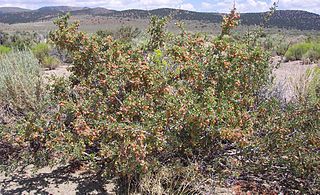
Prunus andersonii is a species of shrub in the rose family, part of the same genus as the peach, cherry, and almond. Its common names include desert peach and desert almond. It is native to eastern California and western Nevada, where it grows in forests and scrub in desert and mountains. It was named after Charles Lewis Anderson by Asa Gray.
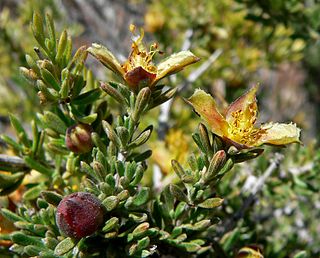
Coleogyne ramosissima or blackbrush, is a low lying, dark grayish-green, aromatic, spiny, perennial, soft wooded shrub, native to the deserts of the southwestern United States. It is called blackbrush because the gray branches darken when wet by rains. It is in the rose family (Rosaceae), and is the only species in the monotypic genus Coleogyne.

Ceanothus spinosus, with the common names greenbark and redheart, is a species of Ceanothus. It is native to southern California and northern Baja California, where it grows in the scrub and chaparral of the coastal mountain ranges.
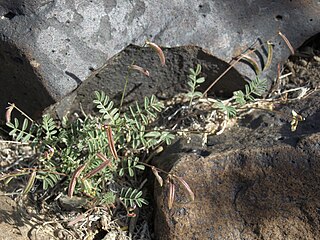
Astragalus acutirostris is a species of milkvetch known by the common name sharpkeel milkvetch. It is native to the Mojave Desert and surroundings of California, Nevada, and Arizona, where it grows in dry, sandy, gravelly areas.

Astragalus kentrophyta is a species of milkvetch known by the common name spiny milkvetch. It is native to western North America from central to west Canada, to California, to New Mexico. It grows in rocky mountainous areas, such as the Sierra Nevada, and on plateaus.
Atriplex spinifera is a species of saltbush, known by the common names spiny saltbush and spinescale saltbush.

Brickellia desertorum is a species of flowering plant in the family Asteraceae known by the common names desert brickellbush and desert brickellia. It is native to Mexico, Central America, the West Indies, and the southwestern United States.

Acmispon procumbens, synonym Lotus procumbens, is a species of legume endemic to California. It is known by the common name silky deerweed. It is known from many habitat types in several regions from the Central Valley to the Mojave Desert to the Peninsular Ranges.

Menodora spinescens is a species of flowering plant in the olive family known by the common name spiny menodora. It is native to the southwestern United States, where it grows in varied mountain, canyon, and desert habitat in California, Nevada, Utah and Arizona.
Rhinotropis subspinosa, synonym Polygala subspinosa, is a species of flowering plant in the milkwort family known by the common name spiny milkwort. It is native to the southwestern United States, where it grows in desert and plateau habitat. It is a perennial herb or small shrub growing in a clump no more than 25 centimeters tall. The stems have woody bases and green, thorn-tipped branches. The leaves are up to 3 centimeters in length and generally oval in shape. The flowers have winglike pairs of bright pink sepals and the keeled central petal is tipped with a yellowish beak, sometimes fringed at the tip.
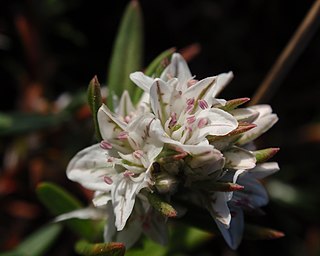
Polygonum paronychia is a species of flowering plant in the knotweed family known by the common names dune knotweed, black knotweed, and beach knotweed. It is native to the coastline of western North America from British Columbia to California, where it grows in sandy coastal habitat such as beaches, dunes, and scrub.

Grindelia ciliata is a species of flowering plant in the family Asteraceae known by the common names Spanish gold, goldenweed, and waxed goldenweed.

Psorothamnus arborescens is a species of flowering plant in the legume family known by the common name Mojave indigo bush.

Psorothamnus polydenius is a species of flowering plant in the legume family known by the common names Nevada dalea and Nevada indigobush. It is native to the deserts of the southwestern United States from the Mojave Desert in California to Utah.
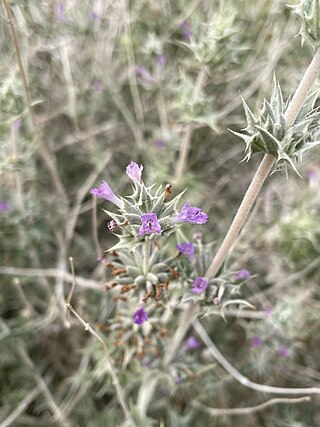
Salvia greatae is a species of flowering plant in the mint family, Lamiaceae. Its common names include Orocopia sage and lavender sage.

Senna didymobotrya is a species of flowering plant in the legume family known by the common names African senna, popcorn senna, candelabra tree, and peanut butter cassia. It is native to Africa, where it can be found across the continent in several types of habitats.

Symphoricarpos longiflorus is a species of flowering plant in the honeysuckle family known by the common names desert snowberry and fragrant snowberry. It is native to the western United States from the Great Basin to western Texas, as well as northwestern Mexico.
Tetradymia argyraea is a species of flowering plant in the aster family known by the common names striped cottonthorn and striped horsebrush. It is native to the desert mountains of the southwestern United States, particularly of California, Nevada, and Arizona, where it grows in desert woodland habitat. It is a woolly, spiny shrub growing one half to nearly two meters in maximum height. The erect stems are white-woolly except for bare stripes at intervals. The leaves are linear in shape and harden as they age, becoming spiny. The larger leaves are woolly and there are clusters of smaller, threadlike leaves which may be hairless. The inflorescence bears two to five flower heads which are each enveloped in five thick phyllaries coated in white woolly hairs. Each head contains five pale yellow flowers each around a centimeter long. Flowers are produced in summer, as late as September. The fruit is an achene a few millimeters long tipped with a pappus of bristles.
Xylorhiza orcuttii is a perennial plant in the family Asteraceae known by the common name Orcutt's aster. It is native to southern California and northern Baja California, where it grows in scrubby habitat in the dry canyons of the Sonoran Desert. It often grows in rocky and sandy substrates, clay, and alkaline soils amongst cactus. It is a shrub with branching, mostly hairless stems that may reach 1.5 meters in length. The leaves are lance-shaped to oblong with smooth, toothed, or spiny edges. The inflorescence is a solitary flower head with up to 40 or more lavender or pale blue ray florets, each of which may measure over 3 centimeters in length. Flowering may begin as early as late fall or winter. The fruit is an achene which may be over a centimeter long, including its pappus of bristles.
Peniocereus striatus is a species of cactus known by several common names, including gearstem cactus, cardoncillo, jacamatraca, sacamatraca, and dahlia-rooted cactus. It is endemic to the Sonoran Desert, where it occurs in Baja California, Sinaloa, and Sonora in Mexico and Arizona in the United States.















